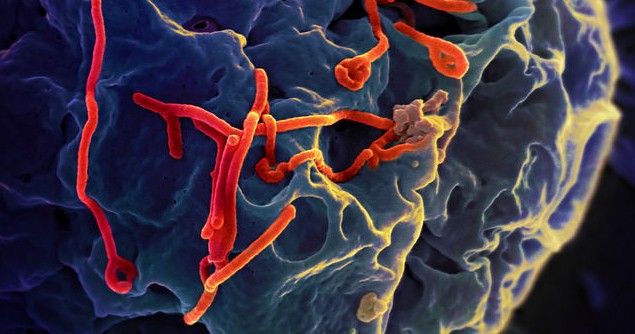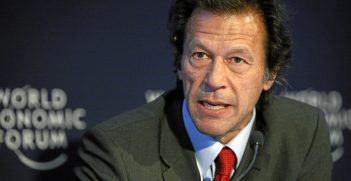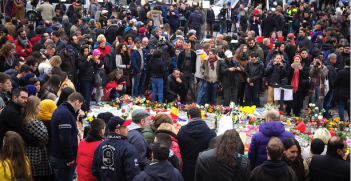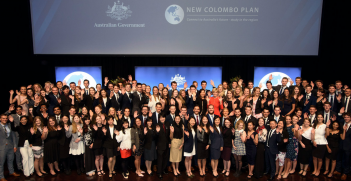The Year in International Affairs: In Pictures

It may be bad news for blog-writers, but images are often what lives on in the memory. When we think back on the year 2014 in international affairs, it will be images that dominate. Images tell stories, give us emotional impressions and condition our understanding of the world. But do the visual representations that we encounter in media coverage always tell the right story? Or do they obscure as much as they reveal?
To test this, look back over the past 12 months in international affairs and see which evocative images dominated the news this year. For example, January began with frosty relations between Indonesia and Australia, with Indonesia having recalled its ambassador to Australia after a Presidential phone-hacking scandal and continued diplomatic tension over asylum seeker boat turn-backs. This photo captures it well. By February, the situation was escalating significantly in the Ukraine with pro-EU protests against the Russian-aligned government turning violent.
After Malaysian Airlines flight MH370 disappeared off the face of the earth on 8 March, we heard about little else for weeks, perhaps due to our collective amazement that, in this age of surveillance and technology, something as large as a plane could vanish in mid-air without a trace. Then in April the world was shocked by the kidnapping of 276 school girls in Nigeria by Boko Haram, with awareness raised via the hashtag #bringbackourgirls.
On 22 May, the Royal Thai Armed Forces, led by General Prayuth Chanocha, received blanket coverage when a coup d’état was launched against Thailand’s caretaker government, resulting in the establishment of the National Council for Peace and Order. In June Sunni extremist group Islamic State declared its government to be a caliphate (out of respect for the dead I haven’t linked to most searing images). In July, attention was drawn back to the Ukraine as Malaysian Airlines Flight MH17 was shot down over territory controlled by pro-Russian separatists, killing all 283 civilian passengers and 15 crew on board.
August saw extensive media coverage of the fallout in Ferguson after the fatal shooting of 18-year-old African American man Michael Brown by white police officer Darren Wilson; the world watched scenes of civil disorder unfold. In September, protests broke out in Hong Kong calling for democratic reform in a movement that became known as the Umbrella Revolution. In October, Prime Minister Tony Abbott introduced AFL slang into the international diplomatic vocabulary when he promised to ‘shirtfront’ Vladimir Putin at the Brisbane G20 Summit.
And, in December, we saw the continuation of the most consistently dominant story of the year: the outbreak and spread of the Ebola virus in West Africa; the year 2014 may be defined according to the global response to this issue.
Putting these images together, what picture do they make for 2014? What story do these images tell?
First, it suggests that mainstream news coverage of international affairs has a tendency to concentrate on only a limited number of issues at a time: for example, the blanket reporting of both Malaysian Airlines incidents. Second, there is a tendency to instil a sense of crisis and to focus on events rather than long-term trends. Third, coverage tends to vastly overstate some risks while ignoring others: for example, global terrorism or Ebola compared to everyday risks like traffic accidents or influenza. Overall the effect is highly pessimistic: a casual observer of international affairs might conclude that everything is getting worse.
The good news is that there are there in fact more encouraging long-term trends. To illustrate, have a look at this alternative set of images that did not so heavily saturate the news. Behind the perception in January that ties with Indonesia were rapidly weakening, is the ongoing reality of Australia’s cultural, aid and civilian links with Indonesia. In February, at the same time as the situation was deteriorating in Kiev, Australia won its case against Japan at the International Court of Justice (ICJ), where judges ruled that Japan’s whaling program could not be justified under the auspices of ‘scientific research’. In March, India was officially announced polio-free by the World Health Organisation.
In April, Australia signed a Free Trade Agreement with South Korea, which was followed by FTAs with Japan in July and with China in November. In May, the Marshall Islands filed a lawsuit in the ICJ against the United States and the world’s eight other nuclear-armed countries and accused them of violating international law in their failure to meet their obligations toward disarmament. In June, London hosted a global summit to end sexual violence in conflict, co-chaired by Angelina Jolie and William Hague, with 123 countries’ delegations showing that the world is serious about combating gender-based violence.
In response to July’s MH17 tragedy, Australia took advantage of its temporary United Nations Security Council seat in pushing for UNSC Resolution 2166 to allow access to international investigators. In August we entered into the final 500 days of the current Millennium Development Goals (MDG’s) which gave us pause to reflect on the remarkable progress made in poverty alleviation since 2000, and to look towards the post-2015 agenda. September saw a peaceful exercise in democracy when Scotland voted in its independence referendum.
Although shirtfronting dominated coverage in the lead-up to G20, there was some great Koala Diplomacy taking place building links between Australia and visiting leaders. November saw the historic deal between the United States and China on climate change insert some momentum into international negotiations. And in December, like a Christmas present to the world, the Arms Trade Treaty comes into effect on Christmas Eve.
Seeing the alternative narratives that emerge when we look beyond the headline-grabbing stories and images reveal a much more positive story about international affairs: one where global public health is improving, people are escaping extreme poverty, the number of electoral democracies is increasing and, in places where there are strong health systems, we can beat back deadly viruses.
Perhaps the year has been more cheerful than we think. We just need to keep the positive picture in mind.
Melissa Conley Tyler is National Executive Director of the Australian Institute of International Affairs and Siobhan Neyland is a research intern at the AIIA’s National Office. This article can be republished with attribution under a Creative Commons Licence.





